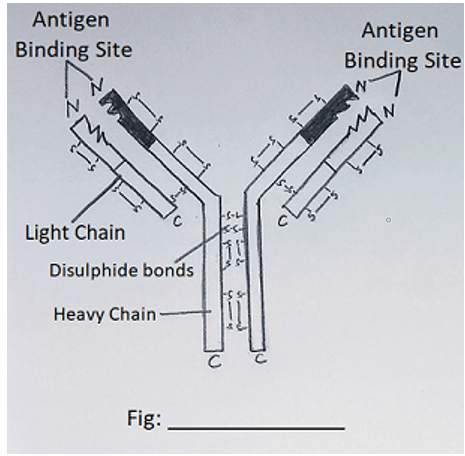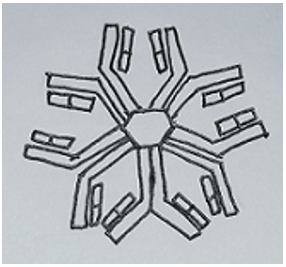This set of Class 12 Biology Chapter 8 Multiple Choice Questions & Answers (MCQs) focuses on “Human Health and Disease – Humoral Immunity-1”.
1. What is the full form of AMI?
a) Antibody-Mediated Immunity
b) Antigen Mediated Immunity
c) Automated Immunity
d) Acquired Mediated Immunity
View Answer
Explanation: The full form of AMI is Antibody-Mediated Immunity. Antibodies are immunoglobulins which are produced in response to antigenic stimulation.
2. which of the following immunities is also called as Antibody-Mediated Immunity?
a) Acquired Immunity
b) Cell-Mediated Immunity
c) Humoral Immunity
d) Innate Immunity
View Answer
Explanation: Humoral Immunity is also called as Antibody-mediated Immunity. Our immune system comprises of the antibodies present in the body humour-blood, lymph. Antibodies protect our body from pathogens that happen to enter blood and lymph.
3. Number of antibodies produced per day during an infection can be _______
a) 2 trillion
b) 20 trillion
c) 200 trillion
d) 2000 trillion
View Answer
Explanation: Number of antibodies produced per day during an infection can be 20 trillion. Antibodies are immunoglobulins which are produced in response to antigenic stimulation.
4. Which structure is depicted by the following figure?

a) Antigen
b) Neutrophil
c) Antibody molecule
d) Basophil
View Answer
Explanation: The above given structure is of an antibody molecule. Each antibody molecule has four peptide chains, two small called as light chains and two longer called heavy chains. Both chains are linked by disulphide bonds.
5. An antibody is represented by which of the following formula?
a) H2L2
b) C1C2
c) A1A2
d) H1L2
View Answer
Explanation: An antibody is represented by H2L2 formula. Each antibody molecule has four peptide chains, two long chains called heavy or H chains and two short chains called light or L chains.
6. Antigenic determinants are ___________
a) Large and complex molecules
b) Proteins or carbohydrates
c) Specific products of pathogen
d) Recognisable sites over antigens
View Answer
Explanation: Antigenic determinants are recognisable sites over antigens. Antigens are generally large molecules. The majority of them are made up of Proteins and Polysaccharides found on the cells walls of bacteria and other cells or the coat of viruses.
7. Which of the following set of antibodies are responsible for providing Natural Passive Immunity to the foetus?
a) IgD and IgE
b) IgM and IgA
c) IgA and IgE
d) IgG and IgA
View Answer
Explanation: IgG and IgA antibodies are responsible for conferring Natural Passive Immunity to the foetus. IgG crosses the placenta during pregnancy and IgA antibodies are present in the yellowish fluid colostrum secreted by mother during the initial days of lactation.
8. Which structure of the antibody is represented by the following figure?

a) IgA
b) IgM
c) IgD
d) IgG
View Answer
Explanation: The given structure represents the structure of IgM. It is present in pentameric form and has 10 paratopes (Antigen Binding Sites).
9. Which of the following is the largest antibody?
a) IgA
b) IgG
c) IgM
d) IgE
View Answer
Explanation: IgM is the largest antibody amongst all because it has 10 paratopes or antigen binding sites. IgG antibody is the smallest amongst all.
10. Which of the following statements is not correct regarding IgM antibody?
a) Responsible for the initial activation of B-cells
b) It is an effective agglutinator of antigen
c) It makes up 7-10% of our total antibodies
d) It is the last antibody to be released during the primary response
View Answer
Explanation: IgM is the first antibody which is released during an infection site. IgM is also responsible for the initial activation of B-cells, macrophages and the complement system. It also makes up 7-10% of our total antibodies.
11. Which of the following is not the function of an antibody?
a) Lysis
b) Neutralisation
c) Assimilation
d) Precipitation
View Answer
Explanation: Assimilation is not the function of an antibody. The functions of antibodies include Lysis, Neutralisation, Opsonisation, Precipitation and Agglutination.
12. Which of the following antibodies shows Opsonisation?
a) IgG
b) IgE
c) IgD
d) IgA
View Answer
Explanation: IgG shows Opsonisation property. It is a property of Adherence where non-palatable antigen becomes palatable which helps in the endocytosis of pathogen by the macrophages.
Sanfoundry Global Education & Learning Series – Biology – Class 12.
To practice all chapters and topics of class 12 Biology, here is complete set of 1000+ Multiple Choice Questions and Answers.
If you find a mistake in question / option / answer, kindly take a screenshot and email to [email protected]
- Check Class 12 - Biology Books
- Practice Class 12 - Physics MCQs
- Practice Class 11 - Biology MCQs
- Practice Class 12 - Chemistry MCQs
- Practice Class 12 - Mathematics MCQs
